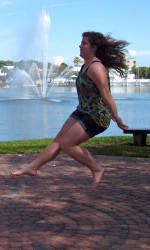
Inside the Shell: Meet Caitlin Morrison
March 7, 2012
CORAL GABLES, Fla.–This year the women’s rowing team will compete in 10 regattas throughout the country, representing Miami in such places as Chattanooga, Tenn., Philadelphia and San Diego. We want []_[] to learn more about the exceptional women that are a part of the Hurricane Rowing Family, so we are taking you “Inside the Shell.” Over the next few weeks we will post Q&As, feature stories and other multimedia segments on the student-athletes.

Gettin’ Jiggy With Caitlin Morrison
What do rowing and Irish Step Dancing have in common? Almost nothing, but Caitlin Morrison can do both. She may be a novice on the rowing scene (she joined the team last season), but Irish Dance has certainly provided Morrison with the skills she needs to be a part of the Hurricane crew. Here’s her story:
I grew up with Irish Dance. My sister was an Irish Dancer, my cousin was an Irish Dancer, my grandparents are from Ireland; I was brought up in an Irish community. My sister started dancing when she was eight, and I’m eight years younger than her, so I spent almost every weekend going to dance functions for her. I danced for the McGinley School in Tampa from when I was 12 years old until I retired in college.
There are five levels in Irish Dance: Beginner, Novice, Prizewinner, Preliminary and Open Champion. At a typical dance competition, called a feis [pronounced “fesh”], the dancing begins at 8 a.m. and runs until the late afternoon. In the higher levels you compete in a soft shoe dance and a hard shoe dance. Three judges rate you using a point system, from zero to 100 points. In Irish Dance, there’s no mercy. Either the judges love you and you’re on the podium, or you’re not. They see something they don’t like, and you’re gone. This really prepared me for winning and losing aspect of college athletics.
When people find out I’m an Irish Dancer, they usually think I’m a clogger. My favorite is when people try to imitate it and end up doing leprechaun jumps. A lot of people don’t take Irish Dance as seriously as a normal dance competition or sports, but we practice just as hard as any other sport. We don’t do weightlifting, but we do drills for hours (often to the point of throwing up).
Before I retired, I was the only visually impaired Irish Dancer in the southern region. I have aniridia (a condition in which the iris deteriorates and only the root remains). I never liked the idea of getting special treatment because of it. Some judges loved it, but one judge gave me a zero at the Southern Regional Championships because of it. It doesn’t really affect my dancing, though, other than finding my way around the stage. Rhythm, I think, came easier to me than it did a lot of the girls I danced with. I used to pick up steps by listening to them first and then figuring out the movements that went along with the sounds. I think a big reason why I like rowing is because you don’t need too much vision. Once you get the technique down it’s all about feel and rhythm. When Coach Carter is showing something I have to go up close and look at what he’s doing, but other than that, I’m fine.
Irish Dance has taught me many things that help me in other areas of my life. I decided I wanted to be a stage manager after helping with the dance shows we used to put on in churches and pubs around Tampa. I liked the organization of the shows and finding order in the chaos. I also have a performer’s point of view as a manager, since I’ve danced in shows, and I know how to calm stage nerves from experience. I definitely learned a lot about stage makeup, too.
I still find myself dancing my steps with my hands in class. I always stand with my feet crossed, toes out. When we’re running through a particularly hard set in rowing practice, I go through the hornpipe (an energy-draining hard-shoe dance) in my head. I hated the hornpipe, it took a lot out of me, but it definitely helped build my stamina for rowing. I also learned a thing or two about discipline, patience and camaraderie from my hours at dance practice. Teamwork; finding a way to get along with the people around you—that’s probably the most important thing I took away from Irish Dance, and it has definitely made a difference in my rowing.






